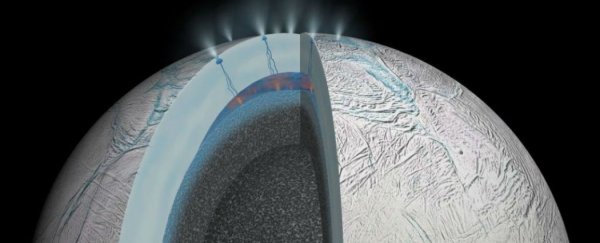It looks like Saturn's icy moon Enceladus has an active hydrothermal system, which is heating a warm ocean at its southern pole, scientists have discovered.
Just last year, scientists discovered that Enceladus has a vast, underground ocean at its south pole. It appears to be sitting under a 30- or 40-kilometre-thick layer of ice, and is itself almost 10 km deep. At the time, there didn't seem to be much evidence of hydrothermal activity connected to the ocean, but researchers from the University of Colorado's Laboratory for Atmospheric and Space Physics in the US have managed to find some in the form of tiny, but significant fragments of minerals.
And when we say tiny, we mean tiny. Discovered by the Cassini spacecraft, these grains are a mere 2 to 8 nanometres in radius, but they can tell us so much. Consisting of mostly silica, just like the masses of sand and quartz particles here on Earth, it's thought that they are the direct result of hydrothermal processes - "the skeletons of evaporated geyser-flung saltwater", says William Herkewitz at Popular Mechanics.
The process that ends up forming these silicate particles begins with the gravitational pull of Saturn and its other moons on Enceladus. This causes a lot of friction, which heats its underground ocean to about 90 degrees Celsius. This hot water gradually dissolves the solid minerals that surround the ocean, and these particles are then carried up towards the surface by the geyser water, which is being rapidly cooled by the icy layer above.
As Sean O'Kane explains at The Verge, once the dissolved particles make their way to the geyser opening to be spewed all over the surface of the moon, they become trapped inside grains of ice. This icy coating will soon be eroded away in the harsh Enceladus atmosphere, which exposes the silicate particles to the elements and Cassini's onboard lab.
"We now have very strong evidence that there is a hot hydrothermal environment at the base of Enceladus's ocean, perhaps like those where we believe life began on Earth," Jonathan Lunine, a planetary scientist at Cornell University who is involved with Cassini but not this particular study, told Popular Mechanics. "This is yet another discovery in a series of really remarkable findings that have come one by one, to tell us that this may be the place to go look for life in the outer Solar System."
The researchers are so good at interpreting this little piece of evidence, they can actually use the size and chemical make-up of the particles to figure out just how much salt is in Enceladus's ocean. Publishing in Nature, they say the upper limit for salinity in the ocean is 4 percent - 3.5 percent is the average in Earth's oceans - and its pH is likely higher than 8.5.
What's really special about this discovery is that many scientists believe hydrothermal vents gave rise to life on Earth - the repeated contact between the hot sea water and surrounding rocks created the energy and nutrients needed to produce and sustain single-celled organisms - so perhaps they will, or have, on Enceladus?
Lee Billings discusses this at Scientific American:
"Today, Earth's active hydrothermal vents are seafloor oases, harbouring ecosystems that flourish in the darkness, isolated from the surface world. Find someplace else beyond Earth where hot rock and water intermingle, and even if it's far from the Sun, life might flourish there, too.
Such systems may have been common early in the Solar System's history, when rocky planets and icy moons were still relatively hot and wet from their initial formation. But until now scientists had no evidence of ongoing hydrothermal activity anywhere beyond Earth."
And with that, Enceladus is our new favourite cosmic body.
Sources: Scientific American, Popular Mechanics, The Verge
